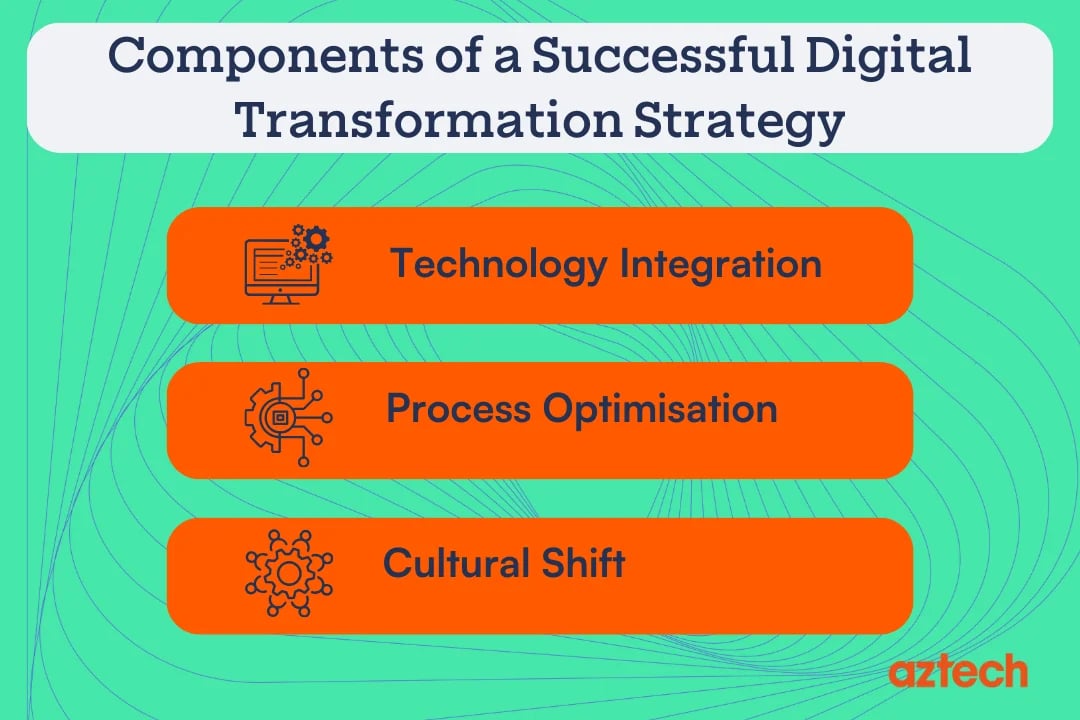Imagine a world where your business thrives, continually adapts and stays ahead of the competition. That’s the power of digital transformation.
In this blog post, we’ll guide you through the ins and outs of it and help you embrace it to maximise your business potential.
Key Takeaways
- Digital transformation is an essential part of modern business strategy, enabling businesses to integrate digital technology into their operations and gain a competitive advantage.
- A successful digital transformation requires tech integration, process optimisation and a cultural shift with clear goals and the right leaders in place.
- To stay competitive in today’s digital world, businesses must leverage cloud computing, AI and automation while addressing legacy systems and security/privacy concerns.
Understanding the Digital Transformation Journey

What is Digital Transformation?
Digital transformation is a term used to describe the integration of technology into all aspects of business operations to improve efficiency, increase competitiveness and ultimately enhance customer experiences.
It involves a fundamental shift in the way organisations operate, embracing digital technologies to not just mimic traditional processes but to revolutionise them. This includes the use of analytics, cloud, AI and automation, and other digital technologies to streamline operations and enhance decision-making.
Fuelled by the need to replace outdated processes and legacy technology, it enables innovation and brings about new technologies through digital transformation projects, such as:
- cloud computing
- artificial intelligence
- big data analytics
- Internet of Things (IoT)
- automation
With the ultimate goal of improving the customer experience.
Yet, the process involves more than just embracing recent technologies; it also includes comprehending the journey of digital transformation and tackling subsequent challenges.
In this journey, businesses must develop a strategy that focuses on creating business value through technology. Success in digital transformation requires an organisation-wide effort, involving leadership, employees, and a shift in mindset.
Why Is It Important?
Digital transformation entails:
Integrating digital technology into all facets of a business processes
- Altering its operations
- Enhancing customer value
- Influencing various industries
- Fostering innovation and competition
In the current digital world, businesses must adopt digital transformation to maintain relevance and profitability. This requires a shift in mindset and a willingness to adapt to new technologies.
Utilising digital technologies enables businesses to simplify processes, scrutinise data, and enhance customer experiences. IT plays a significant role in driving business progress, with CEOs expecting their CIOs to contribute to revenue growth.
Today, the role of IT has expanded beyond just maintaining systems and solving technical issues. They are now strategic partners in the business, helping to identify opportunities for innovation and efficiency. They work hand-in-hand with other departments to ensure that technology investments are aligned with the company's strategic goals.
Furthermore, the use of digital technologies can provide businesses with valuable insights from the data they collect. This data can be used to make informed decisions, predict trends, and personalise the customer experience.
Impact on Industries
Industries across the board are experiencing the effects of digital transformations. Companies leverage technology to fulfil customer expectations and enhance experiences, optimise operations, and develop innovative business models. The COVID-19 pandemic has expedited digital transformations, compelling businesses across industries to adapt to virtual transactions and interactions.
An effective digital business transformation requires a cultural shift within the organisation. IT leaders work in cross-functional teams more than ever and must navigate the challenges of changing workgroups, job titles, and long-established business processes. Strong leadership skills are essential for success, as more than two-thirds of boards of directors accelerated their digital business initiatives due to the COVID-19 disruption.
Components of a Successful Digital Transformation Strategy

MIT Sloan Management Review identifies three main components for a fruitful digital transition strategy which includes technology integration, process optimisation, and cultural shift. Ensuring the right mindset and shared understanding among team members is crucial, as is having the right leaders in place. By modifying standard operating procedures to include new digital technologies and having a clear change story, businesses can create a successful transformation.
Optimising processes during a digital transformation journey involves:
- Setting clear and measurable goals
- Digitising processes
- Automating tasks
- Finding the right balance and process optimisation strategies
- Centralising processes and data
By doing so, businesses can improve efficiency, enhance customer experiences, and achieve their desired outcomes.
Now, let’s examine these three components more closely to understand their contribution.

1. Technology Integration
Technology integration allows businesses to automate processes, analyse data, and improve customer experiences. By incorporating modern technologies, businesses can effectively replace outdated systems with modern solutions that boost operations and customer interactions.
Data is a vital element of digital transformation strategies, as it provides valuable insights that can inform decision-making and drive business growth. The IT team plays a crucial role in selecting, implementing, and managing the technologies that power digital transformation initiatives, ensuring that businesses are equipped with the necessary digital tools and resources to succeed.
2. Process Optimisation
Process optimisation allows businesses to reassess their current processes and enhance them for maximum efficiency and effectiveness in the digital era.
By following a series of carefully planned steps, businesses can transform their processes, leading to:
- Improved efficiency
- Higher quality and consistency
- Increased profitability
- Innovation
To effectively optimise processes, businesses can utilise a range of tools and techniques, including:
- Cloud CRMs
- Business process re-engineering tools
- Integration platforms
- Messaging software
- Reporting tools
- Project management apps
Additionally, methodologies like Kaizen, Six Sigma, and process mapping can help drive optimisation efforts and ensure success in digital transformation.
3. Cultural Shift
Establishing a cultural shift is an integral part of the digital transition. It requires organisations to challenge the status quo, experiment, and adapt to new ways of working. Ensuring everyone is on board with the transformation initiative is key, and having change leaders who are vocal supporters of digital transformation can significantly contribute to its success.
To foster a culture that encourages digital transformation, organisations can:
- Promote collaboration
- Set clear expectations
- Measure progress and success
- Inspire innovation
Real-Life Examples of Digital Transformation

Real-life examples of digital transformation showcase how companies like:
- Domino’s Pizza has implemented the Domino’s Tracker, allowing customers to follow their pizza delivery in real-time. They’ve also introduced voice-activated ordering through Amazon’s Alexa and Google Home, and a mobile app for easy ordering and payment.
- John Deere has integrated GPS technology into their tractors, allowing farmers to optimise their operations and increase productivity.
- Capital One has embraced digital banking and developed a user-friendly mobile app for customers to manage their finances on the go.
These companies have leveraged technology to revolutionise their businesses and drive growth.
Also, these instances exhibit the potential of digital transformation in propelling business growth, enhancing customer experience, and stimulating innovation.
Essential Technologies Driving Digital Transformation

Key technologies propelling digital transformation encompass:
- Cloud Computing
- Artificial Intelligence
- Data Analytics
- The Internet of Things
- Automation
By leveraging these technologies, businesses can innovate, streamline operations, and stay competitive in today’s fast-paced digital world.
Cloud computing provides anytime, anywhere access to applications and data, and helps create new revenue streams by enabling new business models. Artificial intelligence brings real-time decision-making to processes, improving efficiency and driving innovation. Data analytics allows businesses to collect, analyse, and interpret vast amounts of digital data, providing valuable insights that can inform decision-making and drive growth.
Together, these technologies enable businesses to stay agile, adapt to emerging trends, and continually invest in innovation to remain competitive in the ever-evolving digital landscape.
Overcoming Challenges in Digital Transformation

Overcoming hurdles in digital transformation entails tackling legacy systems, organisational resistance, and security and privacy concerns. Legacy systems refer to outdated technology infrastructure that can hinder digital transformation efforts, making it crucial for businesses to invest in modernising their technology infrastructure.
Organisational resistance can be a significant barrier to digital transformation, as it requires strong leadership and effective communication to overcome. Security and privacy concerns must be addressed proactively to protect sensitive data and maintain customer trust during the digital transformation process.
By confronting these challenges, businesses can facilitate a seamless transition to a digital-centric business model, setting themselves up for success in the digital era.
Legacy Systems
Legacy systems can hinder transformation efforts, as they are outdated technology infrastructures that can be costly to maintain, difficult to scale, and may block the flow of information. As a result, businesses must invest in modernising their business models and technology infrastructure to overcome these challenges.
By replacing outdated systems with modern solutions, businesses can streamline operations, enhance customer experiences, and drive growth, ensuring their business value in the digital world.
Organisational Resistance
Organisational resistance can be a significant barrier to digital transformation, as it often stems from a fear of change and loss of control. To overcome this resistance, strong leadership and effective communication are essential. Leaders must demonstrate the benefits of change, promote a learning-oriented mindset, and prioritise employee experience and participation in the transformation process.
By fostering a culture of innovation and collaboration, businesses can effectively tackle organisational resistance and ensure the successful implementation of digital initiatives.
Security and Privacy Concerns
Security and privacy concerns are critical factors to consider during the digital transformation process. Businesses must proactively address these concerns to protect sensitive data, maintain customer trust, and comply with regulatory requirements.
To safeguard their digital transformation efforts, businesses can:
- Develop a proactive and comprehensive cybersecurity strategy
- Recognise existing security threats
- Utilise risk management techniques
- Build a strong data privacy and security framework
- Follow best practices for cybersecurity
By implementing these measures, businesses can reduce risks and ensure a smoother, more secure transformation journey.
Measuring the Success of Digital Transformation
Evaluating the success of digital transformation initiatives is a vital part for businesses to comprehend their progress and modify their strategies as needed. To effectively measure success, businesses can track key performance indicators (KPIs), monitor return on investment (ROI), and evaluate the impact on business objectives and customer experiences.
Taking a portfolio view when measuring digital transformation success allows leaders to assess overall performance rather than focusing on individual projects, creating a better understanding of the risks and opportunities associated with their transformation efforts. By tracking and analysing data, businesses can continually refine their digital transformation strategies, ensuring they stay on the path to success.
The Role of Leadership in Digital Transformation
Leadership assumes a pivotal role in propelling digital transformation. C-level executives are responsible for setting the vision, fostering a culture of innovation, and ensuring cross-functional collaboration. Empathy and trust-building are essential soft skills for leading a digital transformation, as they help to gain the support and commitment of the organisation.
Leaders can influence the culture of innovation in an organisation by:
- Promoting collaboration
- Setting clear expectations
- Measuring progress and success
- Inspiring innovation
By taking an active role in driving digital transformation, leaders can ensure the success of their organisation’s initiatives and contribute to long-term growth and competitiveness.
Preparing for the Future of Digital Transformation
To prepare for the future of digital transformation, businesses need to maintain agility, acclimate to emerging trends and technologies, and persistently invest in innovation. The latest developments in digital transformation include adopting AI and machine learning technologies, automating everyday tasks for efficiency, and moving to the cloud for scalability and flexibility.
By staying aligned with digital trends and investing in the necessary resources and talent, businesses can remain competitive in the ever-changing digital landscape. Embracing innovative approaches, such as:
- Process transformation
- Business model transformation
- Domain transformation
- Cultural/organisational transformation
will empower organisations to leverage their existing strengths and adapt to new challenges.
As the digital landscape continues to evolve, businesses that embrace successful digital transformations and invest in innovation will be better positioned to thrive, outperform their competitors, and create lasting value for their customers and stakeholders.
Summary
In conclusion, digital transformation is a powerful force that can revolutionise businesses, drive growth, and reshape industries. By understanding its journey, addressing challenges, and incorporating digital solutions and strategy, businesses can position themselves for success in the digital world.
As we look to the future, staying agile, adapting to trends, and investing in innovative ideas will be essential for your business goals to remain competitive in this ever-evolving market trend.
Frequently Asked Questions
What are the 4 main areas of digital transformation?
Digital transformation can take place across four main areas: customer experience, operational process, information, and organisation.
What are the 4 Ps of digital transformation?
Digital transformation can be broken down into four core components: People, Process, Platform and Product.
What is an example of a digital transformation?
AI-powered chatbots are an example of digital transformation; they provide a welcoming presence on websites and reduce the time customers have to wait to reach an agent.
What is digital transformation in simple words?
Digital transformation means integrating digital technologies into all business areas to create new processes, modify existing ones, and deliver better customer experiences. It's about reimagining how businesses operate in the digital age.
What are the key components of a successful digital transformation strategy?
Effective digital transformation strategies are built on technology integration, process optimisation and a shift in business culture. These elements come together to create an effective digital roadmap.

-1.png?width=552&height=678&name=text-image%20module%20desktop%20(4)-1.png)


.png?width=2000&name=Case%20study%20(21).png)


-2.png?width=422&height=591&name=text%20image%20tablet%20(31)-2.png)






